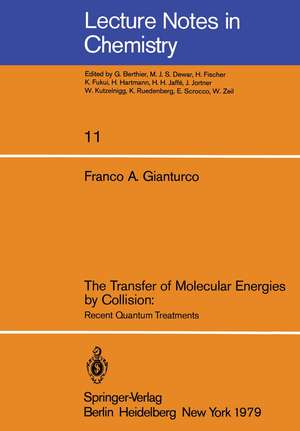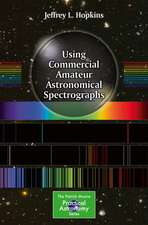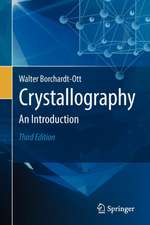The Transfer of Molecular Energies by Collision: Recent Quantum Treatments: Lecture Notes in Chemistry, cartea 11
Autor F. A. Gianturcoen Limba Engleză Paperback – oct 1979
Din seria Lecture Notes in Chemistry
-
 Preț: 96.74 lei
Preț: 96.74 lei - 18%
 Preț: 1123.35 lei
Preț: 1123.35 lei - 18%
 Preț: 776.72 lei
Preț: 776.72 lei - 18%
 Preț: 779.57 lei
Preț: 779.57 lei - 18%
 Preț: 1005.74 lei
Preț: 1005.74 lei - 18%
 Preț: 997.88 lei
Preț: 997.88 lei - 18%
 Preț: 1004.00 lei
Preț: 1004.00 lei - 18%
 Preț: 1136.30 lei
Preț: 1136.30 lei - 18%
 Preț: 1117.03 lei
Preț: 1117.03 lei - 18%
 Preț: 1006.55 lei
Preț: 1006.55 lei - 18%
 Preț: 903.62 lei
Preț: 903.62 lei -
 Preț: 377.73 lei
Preț: 377.73 lei -
 Preț: 395.63 lei
Preț: 395.63 lei - 18%
 Preț: 728.43 lei
Preț: 728.43 lei - 18%
 Preț: 782.57 lei
Preț: 782.57 lei - 18%
 Preț: 1112.78 lei
Preț: 1112.78 lei - 15%
 Preț: 688.13 lei
Preț: 688.13 lei - 15%
 Preț: 646.62 lei
Preț: 646.62 lei - 18%
 Preț: 1124.30 lei
Preț: 1124.30 lei -
 Preț: 384.86 lei
Preț: 384.86 lei -
 Preț: 383.71 lei
Preț: 383.71 lei -
 Preț: 378.71 lei
Preț: 378.71 lei -
 Preț: 384.09 lei
Preț: 384.09 lei -
 Preț: 387.42 lei
Preț: 387.42 lei -
 Preț: 388.90 lei
Preț: 388.90 lei -
 Preț: 393.35 lei
Preț: 393.35 lei -
 Preț: 384.09 lei
Preț: 384.09 lei -
 Preț: 377.73 lei
Preț: 377.73 lei -
 Preț: 382.95 lei
Preț: 382.95 lei -
 Preț: 384.70 lei
Preț: 384.70 lei - 15%
 Preț: 644.63 lei
Preț: 644.63 lei -
 Preț: 386.00 lei
Preț: 386.00 lei -
 Preț: 389.70 lei
Preț: 389.70 lei -
 Preț: 384.09 lei
Preț: 384.09 lei -
 Preț: 385.25 lei
Preț: 385.25 lei -
 Preț: 392.21 lei
Preț: 392.21 lei -
 Preț: 386.00 lei
Preț: 386.00 lei -
 Preț: 403.37 lei
Preț: 403.37 lei -
 Preț: 378.71 lei
Preț: 378.71 lei -
 Preț: 383.50 lei
Preț: 383.50 lei -
 Preț: 390.63 lei
Preț: 390.63 lei -
 Preț: 389.31 lei
Preț: 389.31 lei
Preț: 393.35 lei
Nou
Puncte Express: 590
Preț estimativ în valută:
75.28€ • 81.74$ • 63.23£
75.28€ • 81.74$ • 63.23£
Carte tipărită la comandă
Livrare economică 22 aprilie-06 mai
Preluare comenzi: 021 569.72.76
Specificații
ISBN-13: 9783540097013
ISBN-10: 3540097015
Pagini: 340
Ilustrații: VIII, 329 p.
Dimensiuni: 170 x 244 x 18 mm
Greutate: 0.54 kg
Ediția:Softcover reprint of the original 1st ed. 1979
Editura: Springer Berlin, Heidelberg
Colecția Springer
Seria Lecture Notes in Chemistry
Locul publicării:Berlin, Heidelberg, Germany
ISBN-10: 3540097015
Pagini: 340
Ilustrații: VIII, 329 p.
Dimensiuni: 170 x 244 x 18 mm
Greutate: 0.54 kg
Ediția:Softcover reprint of the original 1st ed. 1979
Editura: Springer Berlin, Heidelberg
Colecția Springer
Seria Lecture Notes in Chemistry
Locul publicării:Berlin, Heidelberg, Germany
Public țintă
ResearchCuprins
1. A Résumé of Quantum Mechanical Potential Scattering.- 1.1. General formulation of the problem.- 1.2. Solutions of the radial equation.- 1.3. The method of partial waves.- 1.4. Some properties of ??. The Born approximation.- 1.5. Properties of the S-matrix: bound states and resonances.- 1.6. Classical and semiclassical scattering,a set of definitions.- References.- 2. Potential Energy Hypersurface Calculations for Simple Systems.- 2.1. Kinematic considerations.- 2.2. General development of a priori method.- 2.3. Some approximate treatments.- 2.4. The electron gas model.- 2.5. A survey of recent applications.- References.- 3. Rotational and Vibrational Inelasticity in Molecular Encounters.- 3.1. Introduction.- 3.2. Quantum treatments of inelastic collisions.- 3.3. The rotational behaviour of molecules.- 3.4. Rotational excitation in atom-molecule collisions: the SF reference frame.- 3.5. Rotational excitation in atom-molecule collision: the helicity representation.- 3.6. The vibro-rotational extension.- 3.7. Molecule- molecule inelastic encounters.- 3.8. Applications.- References.- 4. Dimensionality Reduction Methods for Rotovibrational Cross Section Calculations.- 4.1. Introduction.- 4.2. The CS approach.- 4.3. The sudden approximation methods.- 4.4. The effective potential treatment.- 4.5. The BSA treatments of purely vibrational inelasticity.- 4.6. The LD simplifications.- 4.7. The distorted wave approximations.- 4.8. General conclusions.- References.- 5. Numerical Methods for the Coupled Equations: A Survey.- 5.1. Introduction.- 5.2. The De Vogelaere’s method.- 5.3. The Numerov methods.- 5.4. The methods of piecewise analytic solutions.- 5.5. The solutions via integral equations.- 5.6. The coupled channel R-matrix methods.- 5.7. The variable phase methods.-References.- 6. Rotovibrational Relaxation Models in Simple Gases.- 6.1. Introductions.- 6.2. An outline of experiments.- 6.3. The rate equations.- 6.4. The H2 — He relaxations and other examples.- References.



